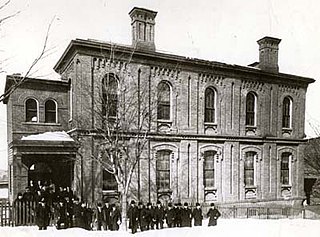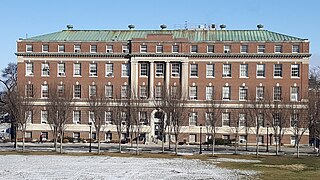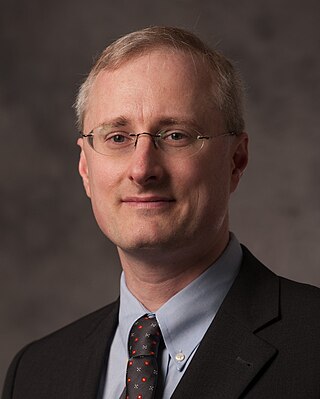
Rensselaer Polytechnic Institute is a private research university in Troy, New York, United States. It is the oldest technological university in the English-speaking world and the Western Hemisphere. It was established in 1824 by Stephen Van Rensselaer and Amos Eaton for the "application of science to the common purposes of life".

Amos Eaton was an American botanist, geologist, and educator who is considered the founder of the modern scientific prospectus in education, which was a radical departure from the American liberal arts tradition of classics, theology, lecture, and recitation. Eaton co-founded the Rensselaer School in 1824 with Stephen van Rensselaer III "in the application of science to the common purposes of life". His books in the eighteenth century were among the first published for which a systematic treatment of the United States was attempted, and in a language that all could read. His teaching laboratory for botany in the 1820s was the first of its kind in the country. Eaton's popular lectures and writings inspired numerous thinkers, in particular women, whom he encouraged to attend his public talks on experimental philosophy. Emma Willard would found the Troy Female Seminary, and Mary Mason Lyon, the Mount Holyoke Female Seminary. Eaton held the rank of senior professor at Rensselaer until his death in 1842.

Biocatalysis refers to the use of living (biological) systems or their parts to speed up (catalyze) chemical reactions. In biocatalytic processes, natural catalysts, such as enzymes, perform chemical transformations on organic compounds. Both enzymes that have been more or less isolated and enzymes still residing inside living cells are employed for this task. Modern biotechnology, specifically directed evolution, has made the production of modified or non-natural enzymes possible. This has enabled the development of enzymes that can catalyze novel small molecule transformations that may be difficult or impossible using classical synthetic organic chemistry. Utilizing natural or modified enzymes to perform organic synthesis is termed chemoenzymatic synthesis; the reactions performed by the enzyme are classified as chemoenzymatic reactions.

Jonathan S. Dordick is an institute professor of chemical and biological engineering at Rensselaer Polytechnic Institute and holds joint appointments in the departments of biomedical engineering and biological sciences. In 2008 he became director of the Center for Biotechnology and Interdisciplinary Studies. In 2012 Dordick became the vice president for research at RPI. He became Special Advisor to the RPI President for Strategic Initiatives in 2018,

Richard Gilman Folsom was an American mechanical engineer, professor of mechanical engineering at the University of California at Berkeley, and the twelfth president of Rensselaer Polytechnic Institute. He also known as the 91st president of the American Society of Mechanical Engineers in the year 1972–73.

The Winslow Chemical Laboratory, now known as the Winslow Building, is a building on the Rensselaer Polytechnic Institute campus in Troy, New York, United States, which finished construction in 1866. It is named in honor of the 5th President of RPI, John F. Winslow, who donated half of the construction cost. The building is brick with stone trimmings and was originally constructed with butternut, chestnut and black walnut. The whole building was fitted for complete courses in general and analytical chemistry. The design and construction was overseen by Professor Henry B. Nason, head of the department of chemistry at the Institute. The lower story contained a metallurgical laboratory and second story contained a chemical laboratory, store rooms and work rooms. The laboratory could accommodate about 40 students. The third story contained a lecture room, a private study, the library and a recitation room. The library of chemical books was established by a donation of several sets of journals and a gift of three hundred dollars from John F. Winslow.
Robert Gustav Loewy was an American aerospace engineer who has been influential in the development of rotary-wing vertical take-off and landing aircraft.
The history of Rensselaer Polytechnic Institute (RPI) spans nearly two hundred years beginning with its founding in 1824. RPI is the oldest continuously operating technological university in both the English-speaking world and the Americas. The Institute was the first to grant a civil engineering degree in the United States, in 1835. More recently, RPI also offered the first environmental engineering degree in the United States in 1961, and possibly the first ever undergraduate degree in video game design, in 2007.
G. K. Surya Prakash is a Distinguished Professor of Chemistry, Chemical Engineering and Materials Science and holder of the George A. and Judith A. Olah Nobel Laureate Chair in Hydrocarbon Chemistry at the Department of Chemistry at the University of Southern California. He serves as the Director of the Loker Hydrocarbon Research Institute, where he maintains his prominent research lab. He also served as the Chairman of the Chemistry Department for four years between 2017 and 2021. He received a B.Sc. (Hons) from Bangalore University in 1972, a M.Sc. from IIT Madras in 1974 and a Ph.D. from University of Southern California in 1978 under the direction of George Olah, where he worked on characterizing stable carbocations in superacids. He also sits on several editorial boards of major scientific journals.

Henry Bradford Nason was a United States chemist.

Benjamin Guy Davis is a British chemist who is Professor of Chemical biology in the Department of Pharmacology and a member of the Faculty in the Department of Chemistry at the University of Oxford and a Fellow of Pembroke College, Oxford. He holds the role of Science Director for Next Generation Chemistry (2019-2024) and Deputy Director (2020-) at the Rosalind Franklin Institute.

Nigel Shaun Scrutton is a British biochemist and biotechnology innovator known for his work on enzyme catalysis, biophysics and synthetic biology. He is Director of the UK Future Biomanufacturing Research Hub, Director of the Fine and Speciality Chemicals Synthetic Biology Research Centre (SYNBIOCHEM), and Co-founder, Director and Chief Scientific Officer of the 'fuels-from-biology' company C3 Biotechnologies Ltd. He is Professor of Enzymology and Biophysical Chemistry in the Department of Chemistry at the University of Manchester. He is former Director of the Manchester Institute of Biotechnology (MIB).
Pierre Sinaÿ, born on April 11, 1938, in Aulnay-sous-Bois (Seine-et-Oise), is a French organic chemist.

Ricketts Building is a building that is home to the Department of Chemical and Biological Engineering at the Rensselaer Polytechnic Institute in Troy, New York. It is named for Palmer C. Ricketts, the ninth president of Rensselaer Polytechnic Institute. The building opened in 1935. It is currently used for labs, lectures, and some clubs.
Nicholas John Turner, is a British chemist and a Professor in the Department of Chemistry at The University of Manchester. His research in general is based on biochemistry and organic chemistry, specifically on biotechnology, cell biology, biocatalysis and organic synthesis.

Gaetano T. Montelione is an American biophysical chemist, Professor of Chemistry and Chemical Biology, and Constellation Endowed Chair in Structural Bioinformatics at Rensselaer Polytechnic Institute in Troy, NY.
David W. Wood is an American chemical engineer who is professor of chemical and biomolecular engineering at Ohio State University. Wood is also associated with the Department of Chemistry and Biochemistry and Molecular Biophysics Training Program.

Juergen Hahn is an American engineering professor. His research focuses on computational systems biology with a specific emphasis on the development of data science approaches and their application to biological pathways relevant to the life sciences.












